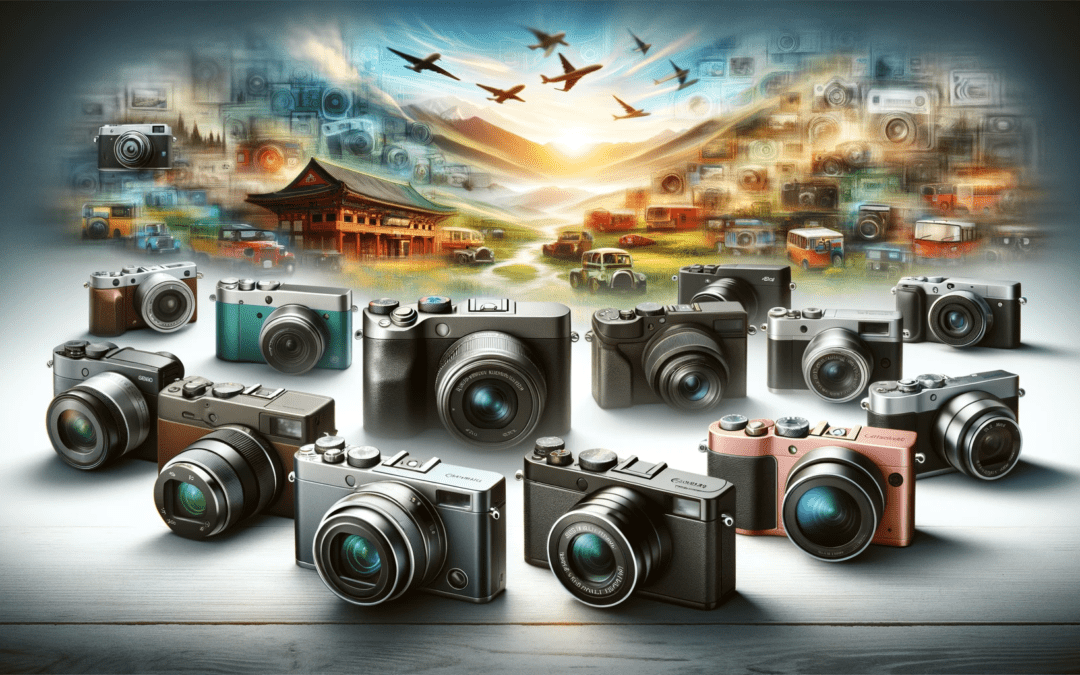In 2024, photography is set to undergo a revolutionary transformation with the introduction of game-changing features in compact cameras. These compact cameras have become an essential tool for shutterbugs and enthusiasts alike, delivering outstanding image quality and versatility in a portable package. With their sleek design and cutting-edge technology, compact cameras have become the go-to choice for capturing unforgettable moments. This year, manufacturers are pushing boundaries to provide photographers with even more innovative features. From groundbreaking sensor technology that enhances low-light performance to advanced autofocus systems that capture fast-moving subjects with precision, the possibilities are limitless. Additionally, built-in artificial intelligence algorithms empower photographers to effortlessly achieve professional-grade results, even for amateurs. These compact cameras empower users to express their creativity beyond traditional boundaries. With features like in-camera editing and connectivity options for seamless sharing on social media, the process of capturing and sharing stunning images has never been more accessible and exciting. As we step into the future of photography, compact cameras are paving the way for a new era of visual storytelling. Get ready to embrace the revolution and capture breathtaking moments like never before.
1. Sony RX100 VII (Amazon)
- Pros: Incredible autofocus, compact size, 4K video capability.
- Cons: High price point, limited touch screen functionality.
- Review: The Sony RX100 VII is a powerhouse in a small package. Boasting a remarkable autofocus system and high-speed performance, it’s perfect for capturing fast-moving subjects. The 4K video recording and flip screen make it a favorite among vloggers. Though pricey, its features justify the investment for serious photographers.
2. Canon Powershot G7 X Mark III (Amazon)
- Pros: Excellent image quality, live streaming capability, compact design.
- Cons: No viewfinder, struggles in low light.
- Review: The Canon Powershot G7 X Mark III stands out with its live streaming feature, appealing to content creators. It delivers crisp images and has a user-friendly interface, ideal for those who want quality without complexity. While the lack of a viewfinder is noted, its overall performance remains impressive.
3. Fujifilm X100V (Amazon)
- Pros: Classic design, superb image quality, enhanced control.
- Cons: No zoom, pricey for a fixed lens camera.
- Review: Fujifilm X100V’s retro look masks its modern capabilities. With a fixed lens that delivers sharp images, and improved ergonomics, it’s a favorite for street and travel photography. The hybrid viewfinder is a unique feature, offering both optical and electronic modes. It’s a premium choice for those valuing aesthetics and quality.
4. Panasonic Lumix LX100 II (Amazon)
- Pros: Large sensor, 4K video, excellent manual controls.
- Cons: Bulky for a compact, fixed screen.
- Review: The Lumix LX100 II is a compelling choice for enthusiasts. Its large sensor in a relatively compact body ensures high-quality images and videos. The manual controls are a joy for those who prefer a hands-on approach. Its size and fixed screen may deter some, but its performance speaks for itself.
5. Ricoh GR III (Amazon)
- Pros: Pocket-sized, sharp lens, effective image stabilization.
- Cons: Fixed focal length, no built-in flash.
- Review: The Ricoh GR III excels in street photography with its discreet size and fast lens. The image stabilization is a boon for handheld shooting. Its fixed focal length encourages creativity, though it may limit versatility. A solid choice for photographers who value portability and image quality.
6. Olympus Tough TG-6 (Amazon)
- Pros: Rugged build, waterproof, macro shooting mode.
- Cons: Small sensor, screen can be hard to see in bright light.
- Review: The Olympus Tough TG-6 is the go-to camera for adventurers. Its durable build can withstand harsh conditions, and the underwater capabilities are exceptional. While the small sensor isn’t ideal for all conditions, its macro mode is a standout feature, perfect for close-up shots in nature.
7. Leica Q2 (Amazon)
- Pros: Full-frame sensor, stunning image quality, luxurious build.
- Cons: Extremely expensive, fixed lens.
- Review: The Leica Q2 is a status symbol in the camera world. With its full-frame sensor and Summilux lens, it delivers images of exceptional quality. The build quality and design are top-notch. It’s a luxury item with performance to match, but the price is prohibitive for many.
8. Nikon Coolpix A1000 (Amazon)
- Pros: 35x optical zoom, built-in viewfinder, 4K video.
- Cons: Slower autofocus, small sensor.
- Review: The Nikon Coolpix A1000 is a versatile travel companion. Its 35x optical zoom covers a vast range, and the 4K video capability is a welcome feature. The viewfinder is handy for bright days. It’s an all-rounder that offers flexibility, though the autofocus speed could be improved.
9. Sony ZV-1 (Amazon)
- Pros: Designed for vlogging, great autofocus, compact.
- Cons: Limited zoom range, no viewfinder.
- Review: The Sony ZV-1 is tailored for vloggers, with features like a flip-out screen, superb video quality, and reliable autofocus. Its compact size makes it highly portable. While the zoom range is modest, it’s an excellent choice for creators focusing on video content.
10. Canon Powershot SX740 HS (Amazon)
- Pros: 40x zoom, compact design, 4K video.
- Cons: No manual controls, small sensor.
- Review: The Canon Powershot SX740 HS is a pocket-friendly powerhouse with a 40x zoom, making it perfect for capturing distant subjects. The 4K video adds to its appeal. Though it lacks manual controls, its ease of use and portability make it a great choice for casual photographers and travelers.
The world of compact digital cameras in 2023 is rich with options catering to a variety of needs. From rugged, adventure-ready cameras to sleek models designed for street photography, there’s a camera for every type of photographer. Whether you prioritize image quality, versatility, or specific features like waterproofing or 4K video, you’re sure to find a camera in this list that meets your needs. Here’s to capturing your next great moment!
What are the main features that distinguish compact digital cameras from DSLR and mirrorless cameras?
Compact digital cameras, often referred to as point-and-shoot cameras, are distinguished by their fixed lenses and simplified shooting modes, making them highly user-friendly for casual photographers. Unlike DSLR (Digital Single-Lens Reflex) and mirrorless cameras, which cater to professionals and enthusiasts with interchangeable lenses and manual controls, compact cameras prioritize convenience and portability. They typically feature automatic focus and exposure settings, allowing users to capture high-quality images without the need to adjust complex settings. Additionally, their compact size makes them ideal for travel and everyday photography, easily fitting into a pocket or purse. Some advanced models also offer features like optical zoom, image stabilization, and Wi-Fi connectivity, bridging the gap between basic point-and-shoots and more sophisticated cameras.
How have advancements in smartphone camera technology impacted the compact digital camera market?
The rise of smartphone camera technology has significantly impacted the compact digital camera market, leading to a decline in demand for traditional point-and-shoot cameras. Smartphones now offer high-resolution sensors, advanced imaging algorithms, and a variety of lenses in a single, multi-functional device, making them a convenient choice for casual photography. This has pushed the compact camera segment to innovate, focusing on features that smartphones cannot replicate as effectively, such as optical zoom, superior low-light performance, and longer battery life. Manufacturers have also integrated smart features into compact cameras, such as Wi-Fi and Bluetooth connectivity, allowing for easy sharing and editing of photos akin to smartphone capabilities. This evolution reflects a shift towards niche markets, where compact digital cameras offer specific advantages over the increasingly capable smartphone cameras.
What are the key factors to consider when choosing a compact digital camera?
When selecting a compact digital camera, several key factors should be considered to ensure it meets the user’s needs. Image quality is paramount, influenced by the sensor size, resolution, and lens quality. Larger sensors typically capture more detail and perform better in low light, but they can increase the camera’s size and cost. Optical zoom range is another crucial factor, especially for those looking to capture subjects from a distance, as it allows for flexibility in framing without sacrificing image quality. Additional features such as image stabilization, video recording capabilities, and connectivity options (Wi-Fi, NFC, Bluetooth) can enhance the shooting experience and convenience. Battery life and the camera’s size and ergonomics also play significant roles, particularly for users prioritizing portability and ease of use. Evaluating these factors in the context of one’s photography needs and budget can guide the decision towards the most suitable compact digital camera.
Can compact digital cameras compete with DSLR and mirrorless cameras in terms of image quality?
While compact digital cameras have made significant strides in image quality, DSLRs and mirrorless cameras still hold an edge in professional and high-end photography markets. The key difference lies in sensor size; DSLRs and mirrorless cameras typically use larger APS-C or full-frame sensors, which capture more light and detail, offering superior image quality, especially in low-light conditions. Additionally, the ability to change lenses on DSLR and mirrorless cameras provides versatility and control over image composition, depth of field, and focus that compact cameras cannot match with their fixed lenses. However, advanced compact cameras with larger sensors and high-quality optics can produce excellent images, closely rivaling entry-level DSLRs and mirrorless cameras. For everyday use, travel, and casual photography, modern compact cameras offer a compelling balance of quality, convenience, and portability.
What future developments can we expect in the compact digital camera segment?
The future of compact digital cameras lies in continuous innovation, especially as they face competition from smartphones. Manufacturers are likely to focus on areas where compact cameras can outperform smartphones, such as optical zoom capabilities, low-light performance, and specialized imaging technologies (e.g., underwater photography, 360-degree cameras). Advancements in sensor technology may lead to even better image quality in smaller devices. Furthermore, integration of artificial intelligence for improved autofocus, scene recognition, and image processing could enhance the user experience. Connectivity features like Wi-Fi and Bluetooth will become standard, facilitating seamless sharing and editing of photos. As the line between gadgets blurs, compact cameras might also feature more smartphone-like functionalities, making them an even more versatile tool for photography enthusiasts looking for quality and convenience.











